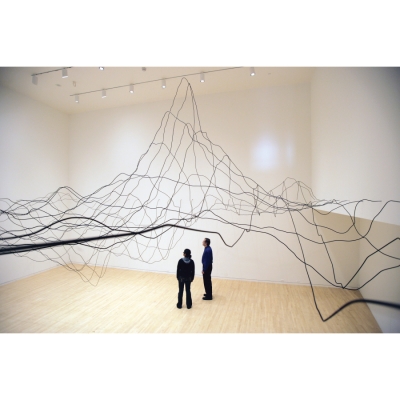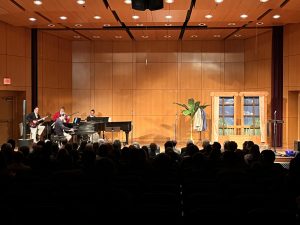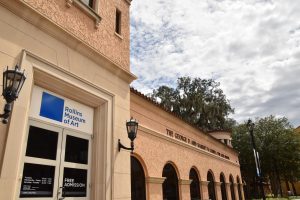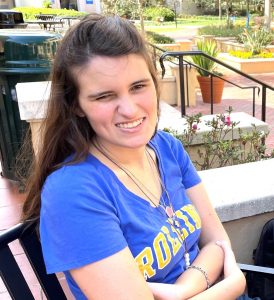![]()
![]() Taking the hybrid form of a wave and hill formation, 2×4 Landscape is a sculpture constructed from 70,000 cut pieces of 2x4s, and fills the entirety of the Orlando Museum of Art’s main gallery.
Taking the hybrid form of a wave and hill formation, 2×4 Landscape is a sculpture constructed from 70,000 cut pieces of 2x4s, and fills the entirety of the Orlando Museum of Art’s main gallery.
The sculpture is just one of the many works in the exhibition, “A History of Water,” that engages the viewer with questions surrounding the sanctity of water and earth. In spite of the large scale of 2×4 Landscape and other works in the exhibition, Lin’s sculptures and installations reflect a calming, meditative quality.
“My indoor work is really quiet,” Lin said. “It’s so subtle you might miss it if you aren’t paying attention.”
“A History of Water” opened on Jan. 29 with a talk from the artist focusing on her ongoing fascination with water’s form. Following her introduction to Milton Van Dyke’s An Album of Fluid Motion in 1993, Lin was inspired to explore wave formation in both her site-specific outdoor works and her indoor studio works. Both 2×4 Landscape and Flow are sculptures that showcase Lin’s early interest in wave shape.
In addition to these sculptures, “A History of Water” includes a collection of Lin’s pin and silver rivers, which are mounted to the gallery walls.
“I fall in love with waterways because they are incredibly important ecologically,” Lin said.
While the silver and pin rivers each capture the image and form of specific waterways, their differing mediums have contrasting effects.
“The pins are about dispersion where as the silvers are about seeing the river as a visualization,” Lin said.
One of the earliest pin rivers in this body of work is the Kissimmee River, a waterway that contributes into Lake Okeechobee and is the source of ecological controversy. In the 1960s, the Army Corps of Engineers dredged a canal down the Kissimmee Valley in an effort to control the river’s flooding; however, this effort caused many environmental problems, and efforts are now underway to restore the waterway’s original course. The complexity of the Kissimmee River and its importance to the Everglades inspired Lin’s interest to creatively understand this waterway.
Lin is also fascinated with the absence of water, citing the need to understand the terrain that forms beneath the surface. This study is reflected in the marble work Around the World, which captures a cross-sectional drawing through the earth at the longitudes of the Equator, New York City and the Arctic Circle.
“These sculptures trace the terrain of the earth without the water present,” Lin said, “They are giving us an idea that most of our mountains are underwater.”
The most interactive work in “A History of Water,” is Lin’s ongoing project, the What is Missing? Foundation. Focusing on endangered and extinct species, this memorial exists online and allows participants to share their memories of personal and historic events of endangering planetary welfare or conservation efforts.
What is Missing? is Lin’s final memorial—notably, her design and construction of the Vietnam Memorial in Washington D.C. was the first work that brought her national acclaim. Unlike her past memorials, What is Missing? allows Lin the freedom to explore in new ways via the Internet.
“We haven’t experimented that much with the medium of the Internet, but it allows us to play with layering, time and sound,” Lin said.
Lin claims this interactive memorial as the work most personally connected to her, noting her role as artist and advocate in the face of an uncertain future.
“I don’t think we have much time, and if I can do anything I will advocate,” Lin said.
“A History of Water” is on view through May 10. For more information or to schedule a tour of the exhibition visit omart.org or call 407-896-4231.







Be First to Comment